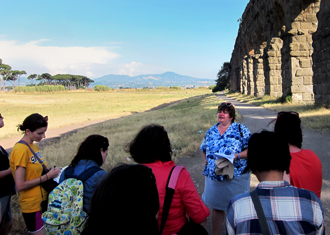Ancient Rome comes alive with classics professor as guide
When in Rome, she looks at a trash heap and sees with the eyes of an archaeologist. This summer while in the Eternal City, Susann Lusnia, an associate professor of classical studies at Tulane University, showed secondary school teachers how to make ancient Rome come alive for their students, too.

Susann Lusnia, associate professor of classical studies, teaches about the aqueducts at Parco degli Acquedotti on the southeast side of Rome, a point where water flowed into the city through the ancient aqueducts. (Photo by Margaret Andrews)
Working chronologically from the Iron Age through the late antique period, Lusnia took the group to Etruscan tombs, the villas “where Horace may have walked,” monuments and museums. Her favorite locale is a “huge, artificial hill entirely made of pot shards from olive oil amphorae,” which was used for two and a half to three centuries as a dump.
Lusnia says, “Most of the participants [in the summer school] have had a language-based education, so this is an introduction for them to material culture the pottery, the metal objects and the stuff of daily life.
“Studying this material is what humanity is all about,” she adds.
Lusnia's curriculum focuses on the Roman Forum, exploring how its function changed over time. With clever engineering, the hilly, swampy site of the Forum was drained to allow settlements to begin. At times, the public assembly place was a civic forum, a public historical and religious monumental center, and a cemetery.
“This tells us something about the population of the time,” Lusnia says. “They drained the land, reclaimed it, and then filled it up.”
For the final exam, Lusnia transported the students to a mystery site, where they were required to draw a sketch map of the site and identify the various Roman building types that they observed, such as a basilica, amphitheater or forum.
A fellow of the American Academy, Lusnia will lead the six-week program again next summer.
